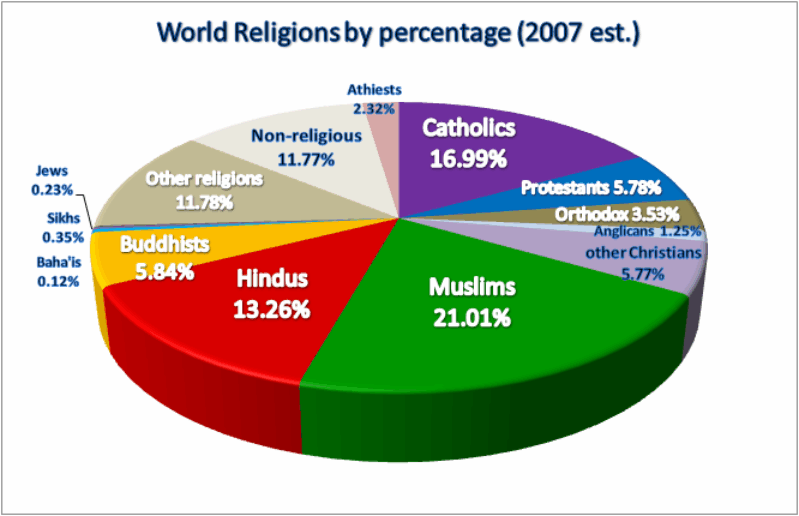The world brims with a rich tapestry of faiths, each contributing to the collective understanding of existence, morality, and purpose. As we peer into the projected religious demographics for 2025, we discover an intricate landscape where numbers tell stories, and beliefs form a mosaic of cultural identity. Among the multitude of religions, Christianity stands as one of the most influential, yet it exists alongside a variety of other belief systems that shape the sociocultural and political arenas of human life. What if we were to ponder: in this diversely religious world, what role does Christianity play, and how might it adapt in the face of ever-evolving demographic trends?
As we explore the anticipated global religious statistics for 2025, we observe significant shifts within the religious affiliations worldwide. Christianity, with its several denominations ranging from Catholicism to Protestantism, currently occupies a substantial percentage of the global population. However, what does this signify in terms of influence, outreach, and spiritual kinship? The primary pillars of Christianity include evangelization and discipleship, yet how effectively are these principles being integrated into a world populated by an increasing number of adherents to other faiths?
To begin with, let us delve into the figures themselves. Christianity, identified by its core tenets of love, grace, and redemption, is anticipated to retain a sizable demographic foothold. Current projections estimate about 2.4 billion Christians throughout the world, constituting approximately one-third of the global populace. This presence not only shapes societal norms but also contributes to moral and ethical discussions on both local and global scales. Yet, there is a palpable undercurrent of competition for influence among burgeoning faiths, especially Islam, which is experiencing remarkable growth.
The anticipated demographic increase of Islam, expected to surpass 1.9 billion adherents by 2025, presents a formidable challenge to the Christian community. This rapid expansion invites Christians to engage with their Muslim counterparts in meaningful dialogue while fostering mutual respect and understanding. It raises an essential question: how can Christian believers embody their faith authentically without compromising their beliefs while engaging in interfaith conversations? The challenge lies not only in coexistence but in ensuring that Christian truths resonate in a pluralistic society.
Further complicating the landscape is the rise of secularism and non-religious identities. Projections reveal a growing population of individuals categorizing themselves as atheists or agnostics. These demographics, which account for approximately 1.2 billion people, pose a unique challenge for Christians. As a faith rooted in the metaphysical, how can Christians express the transformative power of belief to those who may reject the supernatural altogether? The path forward requires a blend of intellectual engagement and heartfelt testimony.
Moreover, in regions traditionally dominated by Christianity, such as Europe and the Americas, statistics indicate a gradual decline in church attendance and affiliation. The reasons for this trend are multifaceted, encompassing cultural shifts, a quest for authenticity, and the accessibility of diverse belief systems through globalization and digital platforms. The question remains: how can the Church revitalize its mission to remain relevant amidst societal changes? Innovative approaches that embrace community service, social justice, and authentic relationships seem imperative for reinvigorating faith.
On a broader scale, it is essential to recognize the interplay between religion and culture. Religious beliefs often serve as guiding principles for ethical behavior, governance, and community cohesion. In this context, Christianity’s ethical teachings have historically encouraged profound social change, addressing issues such as poverty, inequality, and injustice. As the world’s demographics shift, so too must the strategies adopted by Christians to confront these pressing issues. The faith community must not only advocate for righteousness but must also embody it in their daily interactions with both believers and non-believers alike.
The increasing visibility of Eastern religions such as Hinduism and Buddhism, with populations projected to be approximately 1.2 billion and 520 million respectively, adds another layer of complexity to the religious landscape. While these faiths offer distinct yet profound insights into life and spirituality, they also challenge the traditional Christian perspectives. Thus, Christians are called to understand and appreciate these beliefs, recognizing that moments of interfaith dialogue can lead to surprising insights and shared values.
A striking challenge emerges: can Christians engage with the principles of other faiths without diluting their own convictions? Interfaith understanding does not necessitate a lackadaisical approach to one’s own beliefs. Instead, it requires a committed exploration of one’s faith, fortified by an inquisitive spirit characterized by humility and a desire for genuine relationship-building. The purpose transcends mere tolerance; it aims for deeper mutual enrichment.
In conclusion, as we approach the religious demographic landscape anticipated in 2025, Christianity stands at a crossroads, enmeshed in a complex interreligious tapestry. The hold on hearts can no longer be presumed merely based on numbers or tradition. Rather, it demands thoughtful engagement, heartfelt outreach, and a recommitment to the core tenets of Christianity that resonate powerfully with the world’s yearning for meaning and belonging. The question persists: will Christians seize this transformative opportunity to reinforce their presence in a diversely woven world of faith, or will they retreat into the comfort of familiarity? The answer lies in the courage to adapt, innovate, and truly embody the love that their faith professes.



